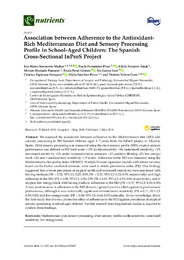Título :
Association between Adherence to the Antioxidant- Rich Mediterranean Diet and Sensory Processing Profile in School-Aged Children: The Spanish Cross-Sectional InProS Project |
Autor :
Navarrete-Muñoz, Eva María 
Fernández Pires, Paula
Navarro-Amat, Silvia
HURTADO-POMARES, MIRIAM 
Peral-Gómez, Paula 
Juárez Leal, Iris 
Espinosa-Sempere, María Cristina 
Sánchez-Pérez, Alicia
Valera-Gran, Desirée |
Editor :
MDPI |
Departamento:
Departamentos de la UMH::Patología y Cirugía
Departamentos de la UMH::Salud Pública, Historia de la Ciencia y Ginecología |
Fecha de publicación:
2019-05-02 |
URI :
https://hdl.handle.net/11000/31286 |
Resumen :
We assessed the association between adherence to the Mediterranean diet (MD) and sensory processing in 583 Spanish children aged 3-7 years from the InProS project in Alicante, Spain. Child sensory processing was measured using the short sensory profile (SSP); atypical sensory performance was defined as SSP total score <155; tactile sensitivity <30; taste/smell sensitivity <15; movement sensitivity <13; under-responsive/seeks sensation <27; auditory filtering <23; low energy/weak <26; and visual/auditory sensitivity <19 scores. Adherence to the MD was measured using the Mediterranean diet quality index KIDMED. Multiple Poisson regression models with robust variance, based on the Huber sandwich estimate, were used to obtain prevalence ratios (PR). Our findings suggested that a lower prevalence of atypical tactile and taste/smell sensitivity were associated with having medium (PR = 0.50, 95% CI: 0.25; 0.99; PR = 0.57, 95% CI: 0.33; 0.99, respectively) and high adherence to the MD (PR = 0.58, 95% CI: 0.34; 0.99; PR = 0.33, 95% CI: 0.19; 0.60, respectively), and of atypical low energy/weak with having medium adherence to the MD (PR = 0.37, 95% CI: 0.16; 0.83). A two-point increase in adherence to the MD showed a general positive effect against atypical sensory performance, although it was statistically significant on taste/smell sensitivity (PR = 0.71, 95% CI: 0.59; 0.85) and low energy/weak (PR = 0.80, 95% CI: 0.64; 0.99) subscales. To our knowledge, this is the first study that shows a protective effect of adherence to the MD against prevalence of atypical sensory processing in school-aged children. Further research from longitudinal studies is required to confirm these findings.
|
Palabras clave/Materias:
Mediterranean diet
sensory processing
short sensory profile
tactile sensitivity
taste/smell sensitivity
low energy/weak |
Tipo documento :
application/pdf |
Derechos de acceso:
info:eu-repo/semantics/openAccess
Attribution-NonCommercial-NoDerivatives 4.0 Internacional |
DOI :
https://doi.org/10.3390/nu11051007 |
Aparece en las colecciones:
Artículos Patología y Cirugía
|
 La licencia se describe como: Atribución-NonComercial-NoDerivada 4.0 Internacional.
La licencia se describe como: Atribución-NonComercial-NoDerivada 4.0 Internacional.
.png)
